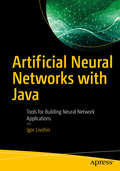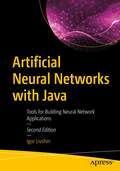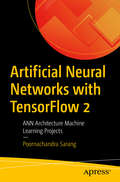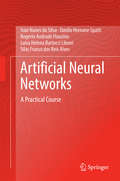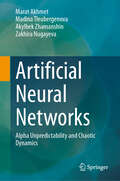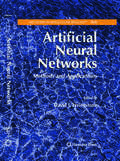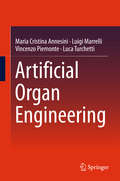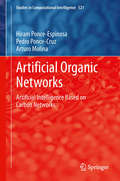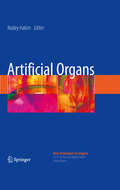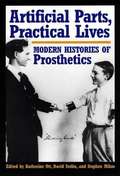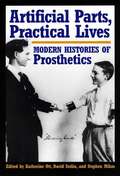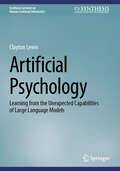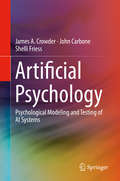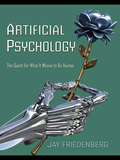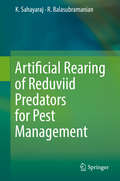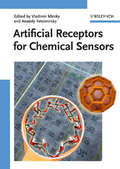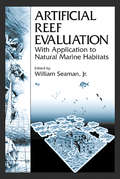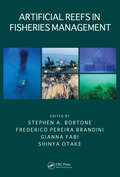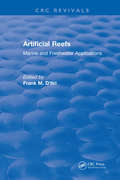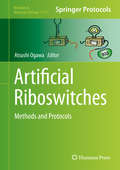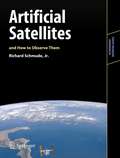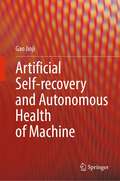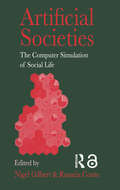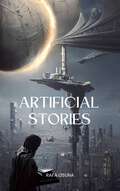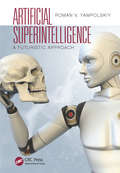- Table View
- List View
Artificial Neural Networks with Java: Tools For Building Neural Network Applications
by Igor LivshinUse Java to develop neural network applications in this practical book. After learning the rules involved in neural network processing, you will manually process the first neural network example. This covers the internals of front and back propagation, and facilitates the understanding of the main principles of neural network processing. Artificial Neural Networks with Java also teaches you how to prepare the data to be used in neural network development and suggests various techniques of data preparation for many unconventional tasks. <P><P> The next big topic discussed in the book is using Java for neural network processing. You will use the Encog Java framework and discover how to do rapid development with Encog, allowing you to create large-scale neural network applications. <P><P> The book also discusses the inability of neural networks to approximate complex non-continuous functions, and it introduces the micro-batch method that solves this issue. The step-by-step approach includes plenty of examples, diagrams, and screen shots to help you grasp the concepts quickly and easily.
Artificial Neural Networks with Java: Tools for Building Neural Network Applications
by Igor LivshinDevelop neural network applications using the Java environment. After learning the rules involved in neural network processing, this second edition shows you how to manually process your first neural network example. The book covers the internals of front and back propagation and helps you understand the main principles of neural network processing. You also will learn how to prepare the data to be used in neural network development and you will be able to suggest various techniques of data preparation for many unconventional tasks. This book discusses the practical aspects of using Java for neural network processing. You will know how to use the Encog Java framework for processing large-scale neural network applications. Also covered is the use of neural networks for approximation of non-continuous functions. In addition to using neural networks for regression, this second edition shows you how to use neural networks for computer vision. It focuses on image recognition such as the classification of handwritten digits, input data preparation and conversion, and building the conversion program. And you will learn about topics related to the classification of handwritten digits such as network architecture, program code, programming logic, and execution. The step-by-step approach taken in the book includes plenty of examples, diagrams, and screenshots to help you grasp the concepts quickly and easily.What You Will LearnUse Java for the development of neural network applicationsPrepare data for many different tasksCarry out some unusual neural network processingUse a neural network to process non-continuous functionsDevelop a program that recognizes handwritten digitsWho This Book Is ForIntermediate machine learning and deep learning developers who are interested in switching to Java
Artificial Neural Networks with TensorFlow 2: ANN Architecture Machine Learning Projects
by Poornachandra SarangDevelop machine learning models across various domains. This book offers a single source that provides comprehensive coverage of the capabilities of TensorFlow 2 through the use of realistic, scenario-based projects.After learning what's new in TensorFlow 2, you'll dive right into developing machine learning models through applicable projects. This book covers a wide variety of ANN architectures—starting from working with a simple sequential network to advanced CNN, RNN, LSTM, DCGAN, and so on. A full chapter is devoted to each kind of network and each chapter consists of a full project describing the network architecture used, the theory behind that architecture, what data set is used, the pre-processing of data, model training, testing and performance optimizations, and analysis. This practical approach can either be used from the beginning through to the end or, if you're already familiar with basic ML models, you can dive right into the application that interests you. Line-by-line explanations on major code segments help to fill in the details as you work and the entire project source is available to you online for learning and further experimentation. With Artificial Neural Networks with TensorFlow 2 you'll see just how wide the range of TensorFlow's capabilities are. What You'll LearnDevelop Machine Learning ApplicationsTranslate languages using neural networksCompose images with style transferWho This Book Is ForBeginners, practitioners, and hard-cored developers who want to master machine and deep learning with TensorFlow 2. The reader should have working concepts of ML basics and terminologies.
Artificial Neural Networks: A Practical Course
by Ivan Nunes da Silva Danilo Hernane Spatti Rogerio Andrade Flauzino Luisa Helena Bartocci Liboni Silas Franco dos Reis AlvesThis book provides comprehensive coverage of neural networks, their evolution, theirstructure, the problems they can solve, and their applications. The first halfof the book looks at theoretical investigations on artificial neural networks and addresses the key architectures that are capable of implementation invarious application scenarios. The second half is designed specifically for theproduction of solutions using artificial neural networks to solve practicalproblems arising from different areas of knowledge. It also describes thevarious implementation details that were taken into account to achieve thereported results. These aspects contribute to the maturation and improvement ofexperimental techniques to specify the neural network architecture that is mostappropriate for a particular application scope. The book is appropriate for students in graduate and upper undergraduate courses in addition to researchers and professional.
Artificial Neural Networks: Alpha Unpredictability and Chaotic Dynamics
by Marat Akhmet Madina Tleubergenova Akylbek Zhamanshin Zakhira NugayevaMathematical chaos in neural networks is a powerful tool that reflects the world’s complexity and has the potential to uncover the mysteries of the brain’s intellectual activity. Through this monograph, the authors aim to contribute to modern chaos research, combining it with the fundamentals of classical dynamical systems and differential equations. The readers should be reassured that an in-depth understanding of chaos theory is not a prerequisite for working in the area designed by the authors. Those interested in the discussion can have a basic understanding of ordinary differential equations and the existence of bounded solutions of quasi-linear systems on the real axis. Based on the novelties, this monograph aims to provide one of the most powerful approaches to studying complexities in neural networks through mathematical methods in differential equations and, consequently, to create circumstances for a deep comprehension of brain activity and artificial intelligence. A large part of the book consists of newly obtained contributions to the theory of recurrent functions, Poisson stable, and alpha unpredictable solutions and ultra Poincaré chaos of quasi-linear and strongly nonlinear neural networks such as Hopfield neural networks, shunting inhibitory cellular neural networks, inertial neural networks, and Cohen-Grossberg neural networks. The methods and results presented in this book are meant to benefit senior researchers, engineers, and specialists working in artificial neural networks, machine and deep learning, computer science, quantum computers, and applied and pure mathematics. This broad applicability underscores the value and relevance of this research area to a large academic community and the potential impact it can have on various fields.
Artificial Neural Networks: Methods and Applications (Methods in Molecular Biology #458)
by David J. LivingstoneIn this book, international experts report the history of the application of ANN to chemical and biological problems, provide a guide to network architectures, training and the extraction of rules from trained networks, and cover many cutting-edge examples of the application of ANN to chemistry and biology. Methods involving the mapping and interpretation of Infra Red spectra and modelling environmental toxicology are included. This book is an excellent guide to this exciting field.
Artificial Organ Engineering
by Luigi Marrelli Vincenzo Piemonte Maria Cristina Annesini Luca TurchettiArtificial organs may be considered as small-scale process plants, in which heat, mass and momentum transfer operations and, possibly, chemical transformations are carried out. This book proposes a novel analysis of artificial organs based on the typical bottom-up approach used in process engineering. Starting from a description of the fundamental physico-chemical phenomena involved in the process, the whole system is rebuilt as an interconnected ensemble of elemental unit operations. Each artificial organ is presented with a short introduction provided by expert clinicians. Devices commonly used in clinical practice are reviewed and their performance is assessed and compared by using a mathematical model based approach. Whilst mathematical modelling is a fundamental tool for quantitative descriptions of clinical devices, models are kept simple to remain focused on the essential features of each process. Postgraduate students and researchers in the field of chemical and biomedical engineering will find that this book provides a novel and useful tool for the analysis of existing devices and, possibly, the design of new ones. This approach will also be useful for medical researchers who want to get a deeper insight into the basic working principles of artificial organs.
Artificial Organic Networks: Artificial Intelligence Based on Carbon Networks (Studies in Computational Intelligence #521)
by Hiram Ponce-Espinosa Pedro Ponce-Cruz Arturo MolinaThis monograph describes the synthesis and use of biologically-inspired artificial hydrocarbon networks (AHNs) for approximation models associated with machine learning and a novel computational algorithm with which to exploit them. The reader is first introduced to various kinds of algorithms designed to deal with approximation problems and then, via some conventional ideas of organic chemistry, to the creation and characterization of artificial organic networks and AHNs in particular. The advantages of using organic networks are discussed with the rules to be followed to adapt the network to its objectives. Graph theory is used as the basis of the necessary formalism. Simulated and experimental examples of the use of fuzzy logic and genetic algorithms with organic neural networks are presented and a number of modeling problems suitable for treatment by AHNs are described: · approximation; · inference; · clustering; · control; · classification; and · audio-signal filtering. The text finishes with a consideration of directions in which AHNs could be implemented and developed in future. A complete LabVIEW(tm) toolkit, downloadable from the book's page at springer. com enables readers to design and implement organic neural networks of their own. The novel approach to creating networks suitable for machine learning systems demonstrated in Artificial Organic Networks will be of interest to academic researchers and graduate students working in areas associated with computational intelligence, intelligent control, systems approximation and complex networks.
Artificial Organs (New Techniques in Surgery Series #4)
by Nadey S. HakimThis book deals with organ failure and the way it can be managed artificially without requiring a transplant. Written by a mixture of European and US physicians and surgeons, each of the chapters compares the artificial organ to what is currently available from the transplant point of view to highlight the current and modern available techniques for organ replacement. The book will be a useful reading for postgraduate students and people interested in modern surgical and medical technology.
Artificial Parts, Practical Lives: Modern Histories of Prosthetics
by Katherine Ott David Serlin Stephen MihmThese essays are valuable first forays into the history of prosthetics. From the wooden teeth of George Washington to the Bly prosthesis, popular in the 1860s and boasting easy uniform motions of the limb, to today's lifelike approximations, prosthetic devices reveal the extent to which the evolution and design of technologies of the body are intertwined with both the practical and subjective needs of human beings. The peculiar history of prosthetic devices sheds light on the relationship between technological change and the civilizing process of modernity, and analyzes the concrete materials of prosthetics which carry with them ideologies of body, ideals, body politics, and culture. Simultaneously critiquing, historicizing, and theorizing prosthetics, Artificial Parts, Practical Lives lays out a balanced and complex picture of its subject, neither vilifying nor celebrating the merger of flesh and machine.
Artificial Parts, Practical Lives: Modern Histories of Prosthetics
by Katherine Ott David Serlin Stephen MihmFrom the wooden teeth of George Washington to the Bly prosthesis, popular in the 1860s and boasting easy uniform motions of the limb, to today's lifelike approximations, prosthetic devices reveal the extent to which the evolution and design of technologies of the body are intertwined with both the practical and subjective needs of human beings. The peculiar history of prosthetic devices sheds light on the relationship between technological change and the civilizing process of modernity, and analyzes the concrete materials of prosthetics which carry with them ideologies of body, ideals, body politics, and culture. Simultaneously critiquing, historicizing, and theorizing prosthetics, Artificial Parts, Practical Lives lays out a balanced and complex picture of its subject, neither vilifying nor celebrating the merger of flesh and machine.
Artificial Psychology: Learning from the Unexpected Capabilities of Large Language Models (Synthesis Lectures on Human-Centered Informatics)
by Clayton LewisThe success of predictive large language models (PLLMs) like GPT3 and ChatGPT has created both enthusiasts and skeptics of their widespread practical applications, but this book argues that the larger significance of such models is contained in what they suggest about human cognition. To explore this potential, the book develops a thought experiment called the Prediction Room, a reference to John Searle’s influential Chinese Room argument, in which a human agent processes language by following a set of opaque written rules without possessing an inherent understanding of the language. The book proposes a new Room model—the Prediction Room with its resident Prediction Agent—generalizing the working of large language models. Working through a wide range of topics in cognitive science, the book challenges the conclusion of Searle’s thought experiment, that discredited contemporary artificial intelligences (AI), through the suggestion that the Prediction Room offers a means of exploring how new ideas in AI can provide productive alternatives to traditional understandings of human cognition. In considering the implications of this, the book reviews an array of topics and issues in cognitive science to uncover new ideas and reinforce older ideas about the mental mechanisms involved in both sides. The discussion of these topics in the book serves two purposes. First, it aims to stimulate new thinking about familiar topics like language acquisition or the nature and acquisition of concepts. Second, by contrasting human psychology with the form of artificial psychology these models exhibit, it uncovers how new directions in the development of these systems can be better explored.
Artificial Psychology: Psychological Modeling and Testing of AI Systems
by John Carbone James A. Crowder Shelli FriessThis book explores the subject of artificial psychology and how the field must adapt human neuro-psychological testing techniques to provide adequate cognitive testing of advanced artificial intelligence systems. It shows how classical testing methods will reveal nothing about the cognitive nature of the systems and whether they are learning, reasoning, and evolving correctly; for these systems, the authors outline how testing techniques similar to/adapted from human psychological testing must be adopted, particularly in understanding how the system reacts to failure or relearning something it has learned incorrectly or inferred incorrectly. The authors provide insights into future architectures/capabilities that artificial cognitive systems will possess and how we can evaluate how well they are functioning. It discusses at length the notion of human/AI communication and collaboration and explores such topics as knowledge development, knowledge modeling and ambiguity management, artificial cognition and self-evolution of learning, artificial brain components and cognitive architecture, and artificial psychological modeling.Explores the concepts of Artificial Psychology and Artificial Neuroscience as applied to advanced artificially cognitive systems;Provides insight into the world of cognitive architectures and biologically-based computing designs which will mimic human brain functionality in artificial intelligent systems of the future;Provides description and design of artificial psychological modeling to provide insight into how advanced artificial intelligent systems are learning and evolving;Explores artificial reasoning and inference architectures and the types of modeling and testing that will be required to "trust" an autonomous artificial intelligent systems.
Artificial Psychology: The Quest for What It Means to Be Human
by Jay FriedenbergIs it possible to construct an artificial person? Researchers in the field of artificial intelligence have for decades been developing computer programs that emulate human intelligence. This book goes beyond intelligence and describes how close we are to recreating many of the other capacities that make us human. These abilities include learning, creativity, consciousness, and emotion. The attempt to understand and engineer these abilities constitutes the new interdisciplinary field of artificial psychology, which is characterized by contributions from philosophy, cognitive psychology, neuroscience, computer science, and robotics. This work is intended for use as a main or supplementary introductory textbook for a course in cognitive psychology, cognitive science, artificial intelligence, or the philosophy of mind. It examines human abilities as operating requirements that an artificial person must have and analyzes them from a multidisciplinary approach. The book is comprehensive in scope, covering traditional topics like perception, memory, and problem solving. However, it also describes recent advances in the study of free will, ethical behavior, affective architectures, social robots, and hybrid human-machine societies.
Artificial Rearing of Reduviid Predators for Pest Management
by K. Sahayaraj R. BalasubramanianThis eye-opening book focuses on the development of techniques to mass-produce reduviid predators and important generalist predators, an endeavor that won't prove sufficient if the cost of commercialization is prohibitive. Advancing mass production to the level of economic feasibility is critical, so that these new technologies can compete in the open market. This book commences with a review of the diversity of reduviid predators in agro-ecosystems world-wide, followed by chapters on their feeding behavior, biology, gut microbiota, their enzyme profile, body protein and genomics, and DNA and field evaluation reports. The field evaluation of reduviids, a worldwide undertaking, is addressed in the last chapter. Each chapter includes a separate conclusion and future recommendations. Detailed information is also included on ingredients and artificial diet preparation, storage and the impact on predators. The artificial rearing of reduviid predator for crop pest management is an essential reference and teaching tool for teachers, researchers and extension workers in developed and developing countries alike, allowing them to produce reduviid predators and important natural enemies in biocontrol and bio-intensive integrated pest management programs. The book offers an excellent resource for all those who are working on beneficial arthropod mass production. It is also an essential reference guide for agricultural and biological sciences scientists, entomologists, crop protection specialists, extension workers, and consultants.
Artificial Receptors for Chemical Sensors
by Vladimir M. Mirsky Anatoly K. YatsimirskyThe first to provide systematically organized information on all three important aspects of artificial receptor design, this book brings together knowledge on an exceptionally hot and multidisciplinary field of research. Strong emphasis is placed on the methodology for discovering artificial receptors, with both definitions for chemosensitivity as well as experimental setups supplied. There follows coverage of numerous classes of artificial receptors, including synthesis, immobilization on surfaces, and quantitative data on properties. The third part of the book focuses on receptor arrays for artificial nose and tongue applications and the whole is rounded off with an outlook and an appendix with all relevant quantitative data on artificial receptors.
Artificial Reef Evaluation: With Application to Natural Marine Habitats
by William SeamanBeneath the coastal waters of the world lie thousands of artificial reefs. Some are old and retired freighters and ships that once plied the oceans of the world but now serve as habitats for marine life. Others are newer reefs that have been designed and built for specific applications. With the field of aquatic habitat technology continually growi
Artificial Reefs in Fisheries Management (CRC Marine Biology Series)
by Stephen A. Bortone Shinya Otake Frederico Pereira Brandini Gianna FabiWhile artificial reefs may have much to offer, they remain an anecdote in the greater scheme of fisheries management, primarily due to the lack of data specific to validating their use. Based on papers presented at the 9th Conference on Artificial Reefs and Artificial Habitats (CARAH) and also including original articles written for this reference,
Artificial Reefs: Marine and Freshwater Applications
by Frank M. D'itriIn this book fisheries biologists, ecologists, limnologists, oceanographers, aquatic resource managers and planners, commercial fisherman and environmental scientists are offered information on the latest artificial fishing reef designs, siting and placement methods, and ecological research as well as an overview of current united states legislation and regulations.
Artificial Riboswitches: Methods and Protocols (Methods in Molecular Biology #1111)
by Atsushi OgawaArtificial riboswitches and other ligand-responsive gene regulators make it possible to switch protein synthesis ON or OFF with arbitrary ligand molecules. Artificial Riboswitches: Methods and Protocols focuses on the state-of-the-art methods developed in recent years for creating artificial riboswitches, therefore this volume could be regarded as a collection of recipes for the gene circuit elements in synthetic biology and metabolic engineering. Chapters cover topics such as screening or rational design methods for obtaining artificial riboswitches that function in either bacterial or eukaryotic translational systems, protocols for evaluating the activities of the resultant riboswitches, as well as protocols for construction of ligand-dependent, trans-acting gene regulators. Written in the successful Methods in Molecular Biology series format, chapters include introductions to their respective topics, lists of the necessary materials and reagents, step-by-step, readily reproducible protocols, and notes on troubleshooting and avoiding known pitfalls. Authoritative and easily accessible, Artificial Riboswitches: Methods and Protocols seeks to serve not only bioengineers who aim to reprogram cell behaviors and molecular biologists who leverage these regulators for genetic studies, but to all researchers interested in this fascinating field.
Artificial Satellites and How to Observe Them (Astronomers' Observing Guides)
by Richard Schmude Jr.Every amateur astronomer - and many non-astronomers - will be familiar with seeing a "star" that shows that characteristic steady slide across the starry background of the sky. Artificial satellites can be seen any night, and some as bright as the planets. But how many of us can identify which satellites or spent launch vehicle casing we are seeing? Artificial Satellites and How to Observe Them describes all the different satellites that can be observed without optical aid, including of course the International Space Station and the many spy satellites operated by different nations. Richard Schmude looks at them in detail and describes how they can be observed by amateurs, how to recognize them, and even how to predict their orbits. Artificial satellites have changed since the beginning of the millenium. Several additional countries have launched them. And amateur astronomers have utilized digital cameras in order to image satellites to a resolution of about three feet. This book describes how to recognize, observe, and image satellites. Examples of recent images and how they were made are given. It also offers up-to-date descriptions of the many satellites that are orbiting the Earth and other celestial bodies. Readers can learn how satellites impact our day-to-day lives. In short, Artificial Satellites and How to Observe Them is a detailed and up-to-date overview of artificial satellites and how to study them in the night sky.
Artificial Self-recovery and Autonomous Health of Machine
by Gao JinjiThis book explores the research fields of engineering cybernetics, bionics, artificial self-recovery and engineering self-recoveries. It explains the scientific and technological research results of artificial self-recovery, autonomous health technology and the application cases of assisted rehabilitation and autonomous health engineering. It provides guidance, latest research trends and development direction for researchers, scholars and engineers engaged in mechanical equipment fault diagnosis and autonomous health.
Artificial Societies: The Computer Simulation Of Social Life (Social Research Techniques And Methods Ser.)
by Nigel Gilbert Rosaria ConteAn exploration of the implications of developments in artificial intelligence for social scientific research, which builds on the theoretical and methodological insights provided by "Simulating societies".; This book is intended for worldwide library market for social science subjects such as sociology, political science, geography, archaeology/anthropology, and significant appeal within computer science, particularly artificial intelligence. Also personal reference for researchers.
Artificial Stories
by Rafa OsunaThis book is not about short stories. Well, it is, it’s not JUST a book about short stories. It is also about an experiment I had to do to make sure just where we stand when it comes to the level of creativity that current AI has. That’s why in this book you’ll find two types of short stories. Some are made by me, and some are made by an AI. For every short story, firstly, you will find the text written by me, and, immediately after, you will find another text with the same title, but written by the AI. The latter are based on the text by me where the AI decided to keep the theme, setting, problem at hand, or… whatever the program wanted in each case. I am responsible for the quality of my stories. You can (and should) criticize me. After all, we’re talking about one of the first literary projects that I publish and I’m aware that I won’t win a Nobel Prize. But, what about the quality of the stories written by the AI? Read them, fabricate opinions. That’s what this experiment is about. Obviously, I have my own opinion, but I won’t talk about it, so it doesn’t change yours. You can find me on the main social medias and reach out, maybe our opinions will concur.
Artificial Superintelligence: A Futuristic Approach
by Roman V. YampolskiyA day does not go by without a news article reporting some amazing breakthrough in artificial intelligence (AI). Many philosophers, futurists, and AI researchers have conjectured that human-level AI will be developed in the next 20 to 200 years. If these predictions are correct, it raises new and sinister issues related to our future in the age of
